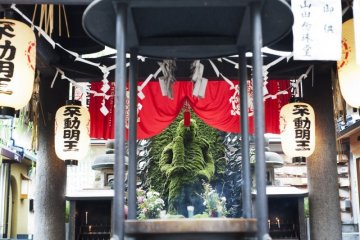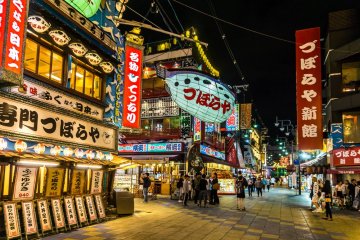
Conoce Los Mejores Lugares Para Comer En Dotonbori-Osa...
Marinthia Jaqueline Estrada LopezDotonbori es EL lugar para vivir la noche en Osaka. ¿Buscas comida rica, barata y auténtica? Te llevo a mis spots secretos donde comen los locales.

Namba Yasaka Shrine is a unique and standout destination among Osaka’s sacred spots. Located in the Namba District, Namba Yasaka is famous for its impressive lion head-shaped building called Ema-Den, which measures 12-meters high by 11-meters wide! Ema-Den and the surrounding temple structures are all post-war reconstructions of the original buildings that were destroyed in air raids and fires in 1945.
Once you enter the relatively small shrine complex, you will come face-to-face with the fierce Ema-Den. The lion’s eyes, slightly tilted down, seem to stare right at you and its wide mouth reveals pointed teeth. Although the Ema-Den’s appearance is intimidating, its open jaw is meant to swallow evil spirits and leave you with good fortune. Ema-Den becomes even more menacing when the sun goes down and its eyes glow against the night. Why not visit this enormous lion head and let it gobble up your worries?
Aside from the lion head, Namba Yasaka Shrine is also a pleasant springtime spot thanks to its numerous cherry blossoms.
On the third Sunday of January, Namba Yasaka Shrine becomes home to the Tug-of-War ritual, which is an intangible folk cultural property of Osaka City. The Shinto event is a celebration of the Japanese myth of Susanoo-no-Mikoto who killed the serpent god Yamata-no-orochi and freed people from hardship.
Namba Yasaka Shrine is a 6-minute walk from Namba Station.

Dotonbori es EL lugar para vivir la noche en Osaka. ¿Buscas comida rica, barata y auténtica? Te llevo a mis spots secretos donde comen los locales.

Among the hustle and bustle of Osaka’s renowned shopping and foodie street, Dotonbori, lies a cobblestone alleyway, Hozenji Yokocho, that leads visitors into old Japan. On the far western end of the alley stands the small, yet locally cherished Hozenji Temple. This Buddhist temple, built in 1637, is dedicated to Fudo Myoo, one of the five wisdom kings. During the 17th century, the temple played host to rakugo storytelling and stage performances in the up-and-coming entertainment district. What Hozenji lacks in space, it makes up for in ambience. Follow cobblestone streets past traditional storefronts to reach the modest temple. If you visit during the early morning, evening, or night, your journey will be bathed in the warm glow of lantern light. Once you reach Hozenji, pass under the entrance into the covered area and approach the principal object of worship, the Fudo Myoo statue, which has a bowl and ladle in front of it. It is customary to ladle water onto the statue when you pray for good luck, thus earning the statue the nickname Mizukake (water-throwing) Fudo. Due to years of prayer, the statue has become perpetually covered in moss, giving it a mystical aura. After praying to Fudo Myoo, enjoy the culture of the area by exploring Hozenji Yokocho’s okonomiyaki shops, izakayas, and multitude of restaurants. For a more high-energy experience, take a short walk to flashy Dotonbori and fill your night with street food, bar hopping, neon lights, and more.

Dotonbori es una calle de Osaka que corre paralela al canal del mismo nombre, es una de las atracciones más famosas de la ciudad y se encuentra en el distrito de Namba de Chuo. Es particularmente conocida por sus numerosos restaurantes, bares y coloridos letreros de neón. La primera piedra de Dotonbori se colocó en 1612, cuando el empresario Yasui Doton quiso construir un canal allí para conectar los dos brazos del río Yokobi y así hacer que el área fuera más atractiva para el comercio. En 1621 el área fue conquistada por el Shogunato Tokugawa y desde entonces se ha llamado Dotonbori (literalmente Canal Doton) y declarado distrito de entretenimiento de Osaka. Hoy encontrará allí una variedad de los restaurantes, bares y puestos de comida más famosos de Osaka. El área es particularmente popular por la noche ya que los edificios están cubiertos por innumerables letreros de neón de colores. Por ejemplo, muchos de los restaurantes se anuncian con letreros grandes, a veces tridimensionales, como el cangrejo de seis metros y medio de altura en el restaurante Kani Doraku.

Kuromon Market, or Kuromon Ichiba, is a staple destination among tourists and residents alike thanks to its abundance of fresh fish, meat, fruits, vegetables, sweets, clothes, and household/ miscellaneous items. The over 170-year old shopping street extends 580-meters long and is home to approximately 150 shops. Peruse large, commercialized shops alongside mom-and-pop spots and immerse yourself in the preserved food culture of Osaka. The lively atmosphere of shoppers, street food vendors, and tantalizing aromas will make for an unforgettable shopping experience. The historic market, officially established in 1902 with the name Enmyoji Ichiba, quickly gained the nickname Kuromon Ichiba, which translates to Black Gate Market, due to the nearby Enmyoji Temple’s renowned black-painted gate. Although the temple was completely destroyed by fire in the early 20th century, the market’s name still persists today. Although Kuromon Market has become a popular tourist destination, it still retains an authentic feel thanks to its local shoppers, cultural offerings, and down-to-earth vibes. The street is full of exciting finds, so be sure to explore them all! Pick up some preserved and pickled vegetables, wasabi root, bamboo shoots, wagyu beef, fugu (blowfish), strawberry daifuku (mochi covered strawberries), anime merchandise, or second-hand kimonos, to name a few. Given that you are surrounded by food, why not try some as well? Thankfully, the market is a hotspot for street food and quick bites on the go. Try some takoyaki, grilled scallops, sushi, oden (assortment of meat skewers, meatballs, fishcake, and daikon radish in a light soy-flavored dashi broth), kushisei (deep-fried meat skewers), okonomiyaki, fresh fruit juice, and so much more. Make sure you come to the market hungry and enjoy Osaka’s cuisine! As you explore the market please be mindful of your trash and support the cleanliness of the area. Towards the southern end of the market is the Kuromon Information Center. The center is a wonderful place to unwind after hours of walking and offers a seating area, toilets, a diaper changing table, a baggage counter, a currency exchange machine, and Chinese- and English-speaking staff onsite.